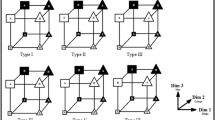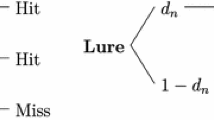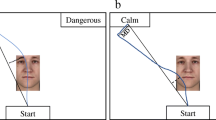Abstract
In this article, we examine the role of category labels in inductive inference. Some leading research has suggested that information about category membership works just like any other feature in categorical inductions, whereas other research has proposed that the influence of category membership on induction goes beyond that of other features. To investigate these claims further, we developed an online measure of judgments that is akin to eyetracking. The judgment results and the mouse-tracking data jointly support the view that category labels do affect inductive inferences in a way distinct from that for feature information. When arbitrary labels conveyed category membership information, participants viewed these labels more often and earlier in a trial, in comparison with cases in which the same labels conveyed non-membership information. Our results suggest that category membership information works like a guide for inference. An ecological rationale for this induction strategy is also discussed.
Similar content being viewed by others
References
Allport, G. W. (1954).The nature of prejudice. Reading, MA: Addison-Wesley.
Anderson, J. R. (1990).The adaptive character of thought. Hillsdale, NJ: Erlbaum.
Corneille, O., Klein, O., Lambert, S., &Judd, C. M. (2002). On the role of familiarity with units of measurement in categorical accentuation: Tajfel and Wilkes (1963) revised and replicated.Psychological Science,13, 380–383.
Duckitt, J. (1992). Psychology and prejudice: A historical analysis and integrative framework.American Psychologist,47, 1182–1193.
Gelman, S. A. (2003).The essential child: Origins of essentialism in everyday thought. Oxford: Oxford University Press.
Gelman, S. A., &Coley, J. D. (1990). The importance of knowing a dodo is a bird: Categories and inference in 2-year-old children.Developmental Psychology,26, 796–804.
Gelman, S. A., &Heyman, G. D. (1999). Carrot-eaters and creaturebelievers: The effects of lexicalization on children’s inferences about social categories.Psychological Science,10, 489–493.
Gelman, S. A., &Markman, E. M. (1986). Categories and induction in young children.Cognition,23, 183–209.
Gigerenzer, G., Todd, P. M., & theABC Research Group (1999).Simple heuristics that make us smart. New York: Oxford University Press.
Hamilton, D. L., &Sherman, J. W. (1994). Stereotypes. In R. S. Wyer, Jr., & T. K. Srull (Eds.),Handbook of social cognition (Vol. 2, pp. 1–68). Hillsdale, NJ: Erlbaum.
Heit, E., &Rubinstein, J. (1994). Similarity and property effects in inductive reasoning.Journal of Experimental Psychology: Learning, Memory, & Cognition,20, 411–422.
Jansen, A. R., Blackwell, A. F., &Marriott, K. (2003). A tool for tracking visual attention: The Restricted Focus Viewer.Behavior Research Methods, Instruments, & Computers,35, 57–69.
Kahneman, D., &Tversky, A. (1973). On the psychology of prediction.Psychological Review,80, 237–251.
Kashima, Y., Woolcock, J., &Kashima, E. S. (2000). Group impressions as dynamic configurations: The tensor product model of group impression formation and change.Psychological Review,107, 914–942.
Kruschke, J. K. (1992). ALCOVE: An exemplar-based connectionist model of category learning.Psychological Review,99, 22–44.
Kunda, Z., Miller, D. T., &Claire, T. (1990). Combing social categories: The role of causal reasoning.Cognitive Science,14, 551–577.
Kunda, Z., &Thagard, P. (1996). Forming impressions from stereotypes, traits, and behaviors: A parallel-constraint-satisfaction theory.Psychological Review,103, 284–308.
Love, B. C., Medin, D. L., &Gureckis, T. M. (2004). SUSTAIN: A network model of category learning.Psychological Review,111, 309–332.
Malt, B. C., &Sloman, S. A. (2004). Conversation and convention: Enduring influences on name choice for common objects.Memory & Cognition,32, 1346–1354.
Malt, B. C., Sloman, S. A., &Gennari, S. P. (2003). Universality and language specificity in object naming.Journal of Memory & Language,49, 20–42.
Markman, A. B., &Gentner, D. (1993). Structural alignment during similarity comparisons.Cognitive Psychology,25, 431–467.
Markman, A. B., &Makin, V. S. (1998). Referential communication and category acquisition.Journal of Experimental Psychology: General,127, 331–354.
Markman, A. B., &Ross, B. H. (2003). Category use and category learning.Psychological Bulletin,129, 592–613.
Markman, E. M. (1989).Categorization and naming in children: Problems of induction. Cambridge, MA: MIT Press.
Medin, D. L., Coley, J. D., Storms, G., &Hayes, B. K. (2003). A relevance theory of induction.Psychonomic Bulletin & Review,10, 517–532.
Medin, D. L., &Ortony, A. (1989). Psychological essentialism. In S. Vosniadou & A. Ortony (Eds.),Similarity and analogical reasoning (pp. 179–195). Cambridge: Cambridge University Press.
Murphy, G. L., &Ross, B. H. (1994). Predictions from uncertain categorizations.Cognitive Psychology,27, 148–193.
Nosofsky, R. M. (1986). Attention, similarity, and the identification-categorization relationship.Journal of Experimental Psychology: General,115, 39–57.
Osherson, D. N., Smith, E. E., Wilkie, O., Lopez, A., &Shafir, E. (1990). Category-based induction.Psychological Review,97, 185–200.
Pothos, E. M. (2005). The rules versus similarity distinction.Behavioral & Brain Sciences,28, 1–49.
Ratcliff, R. (1993). Methods for dealing with reaction time outliers.Psychological Bulletin,114, 510–532.
Rehder, B., &Hoffman, A. B. (2005a). Eyetracking and selective attention in category learning.Cognitive Psychology,51, 1–41.
Rehder, B., &Hoffman, A. B. (2005b). Thirty-something categorization results explained: Selective attention, eyetracking, and models of category learning.Journal of Experimental Psychology: Learning, Memory, & Cognition,31, 811–829.
Rosch, E., &Mervis, C. B. (1975). Family resemblances: Studies in the internal structure of categories.Cognitive Psychology,7, 573–605.
Ross, B. H., Gelman, S. G., &Rosengren, K. S. (2005). Children’s category-based inferences affect classification.British Journal of Developmental Psychology,23, 1–24.
Shafir, E. B., Smith, E. E., &Osherson, D. N. (1990). Typicality and reasoning fallacies.Memory & Cognition,18, 229–239.
Sloman, S. A. (1993). Feature-based induction.Cognitive Psychology,25, 231–280.
Sloman, S. A. (1998). Categorical inference is not a tree: The myth of inheritance hierarchies.Cognitive Psychology,35, 1–33.
Sloutsky, V. M. (2003). The role of similarity in the development of categorization.Trends in Cognitive Sciences,7, 246–251.
Sloutsky, V. M., &Fisher, A. V. (2004). Induction and categorization in young children.Journal of Experimental Psychology: General,133, 166–188.
Stangor, C. (2000).Volume overview. InC. Stangor (Ed.),Stereotypes and prejudice: Essential readings (pp. 1–16). Philadelphia: Psychology Press.
Tajfel, H., &Wilkes, A. L. (1963). Classification and quantitative judgment.British Journal of Psychology,54, 101–114.
Tversky, A., &Kahneman, D. (1983). Extensional versus intuitive reasoning: The conjunction fallacy in probability judgment.Psychological Review,90, 293–315.
Wilcox, R. R. (1998). How many discoveries have been lost by ignoring modern statistical methods?American Psychologist,53, 300–314.
Yamauchi, T. (2005). Labeling bias and categorical induction: Generative aspects of category information.Journal of Experimental Psychology: Learning, Memory, & Cognition,31, 538–553.
Yamauchi, T., &Markman, A. B. (2000). Inference using categories.Journal of Experimental Psychology: Learning, Memory, & Cognition,26, 776–795.
Yamauchi, T., &Yu, N. Y. (2005). Categories and feature inferences: Category membership and a reasoning bias. In B. G. Bara, L. Barsalou, & M. Bucciarelli (Eds.),Proceedings of the 27th Annual Meeting of the Cognitive Science Society (pp. 2404–2409). Mahwah, NJ: Erlbaum.
Yamauchi, T., & Yu, N. Y. (2007).Categories versus feature labels: Category labels polarize inferential predictions. Manuscript in preparation.
Author information
Authors and Affiliations
Corresponding author
Rights and permissions
About this article
Cite this article
Yamauchi, T., Kohn, N. & Yu, NY. Tracking mouse movement in feature inference: Category labels are different from feature labels. Memory & Cognition 35, 852–863 (2007). https://doi.org/10.3758/BF03193460
Received:
Accepted:
Published:
Issue Date:
DOI: https://doi.org/10.3758/BF03193460




